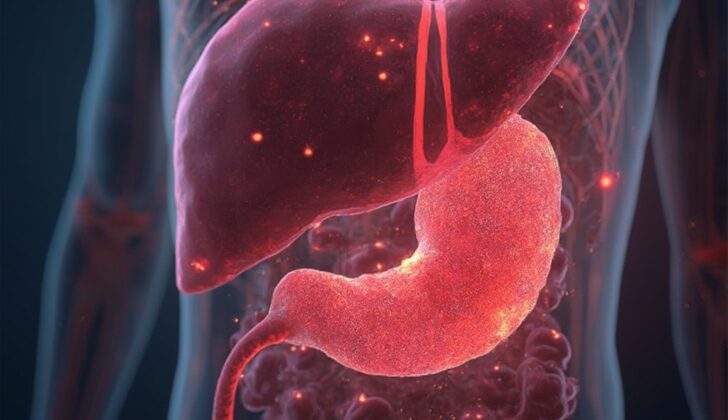What is Autoimmune Hepatitis?
Autoimmune hepatitis is a condition that involves long-term inflammation of the liver, but we don’t fully understand why it happens. It’s believed that the condition develops because of a mixture of genetic factors, something in a person’s environment that triggers the condition, and a failure of the body’s immune system. This results in the liver cells becoming inflamed over a long period, leading to scarring of the liver.
There are two known types of this condition. Type 1 is identified by the presence of certain antibodies called anti-smooth muscle antibodies, either on their own or together with anti-nuclear antibodies. In Type 2 autoimmune hepatitis, different antibodies are present – either anti-liver/anti-kidney microsome type 1 antibodies or anti-liver cytosol type 1 antibodies.
What Causes Autoimmune Hepatitis?
The exact cause of this medical condition is unknown. About 60% of patients with the condition have chronic hepatitis, even though there’s no clear evidence of a viral infection in their test results. Researchers have associated the disease with the presence of certain autoantibodies, specifically anti-smooth muscle autoantibodies, in the patient’s body.
Risk Factors and Frequency for Autoimmune Hepatitis
Autoimmune hepatitis is a health condition that often goes unreported and unrecognized. There are two types of autoimmune hepatitis, with 80% of cases being classified as type 1. Interestingly, type 1 is more common in young or middle-aged females, accounting for 75% of cases. Overall, autoimmune hepatitis affects more females than males at a rate of 3.6 to 1.
- Autoimmune hepatitis often isn’t reported or recognized properly.
- Out of the two types, 80% of cases are diagnosed as type 1.
- Young or middle-aged females are likely to have type 1 autoimmune hepatitis.
- The female to male ratio for the presence of this condition is 3.6:1.
- The exact number of cases in the United States isn’t known yet.
- Every year, it is believed that 100,000 to 200,000 people are affected.
- According to European studies, annually 0.9 to 2 out of every 100,000 people develop autoimmune hepatitis.
- The annual occurrence rate is around 11 to 25 cases per 100,000 people.
- Type 2 autoimmune hepatitis is typically diagnosed in children and young adults.
- Usually, it results in fulminant hepatic failure – a severe impairment of liver function.
Signs and Symptoms of Autoimmune Hepatitis
Autoimmune hepatitis is a condition where the immune system attacks the liver, leading to inflammation. People with this condition might not experience any symptoms at all, which are only discovered during routine blood tests. However, when symptoms do appear, they can vary based on the severity of the liver damage or complications. Most commonly, patients can experience fatigue, discomfort, yellowing of the skin and eyes (jaundice), abdominal pain, and sometimes, joint pain.
It’s rare, but some individuals might first realize they have autoimmune hepatitis when they experience severe signs of liver failure. These can involve fluid build-up in the abdomen (ascites), mental confusion (hepatic encephalopathy), and bleeding in the upper digestive tract (variceal hemorrhage).
In some instances, autoimmune hepatitis can also exist alongside other autoimmune conditions like Graves’ disease, rheumatoid arthritis, celiac disease, type 1 diabetes, ulcerative colitis, hemolytic anemia, and immune thrombocytopenia. Autoimmune hepatitis is found in about 10% of people with autoimmune polyendocrine syndrome type 1.
Interestingly, around one-quarter of people with autoimmune hepatitis don’t show any symptoms. For those with severe disease, the most common physical findings are an enlarged liver (in 78% of cases) and jaundice (in 69% of cases). Another common sign can be an enlarged spleen, with or without cirrhosis (liver scarring).
Testing for Autoimmune Hepatitis
Autoimmune hepatitis should be thought of as a potential cause in individuals showing long-term and sudden signs of liver disease. In diagnosing this condition, it’s essential to rule out other chronic liver diseases including Wilson disease, drug-induced hepatitis, nonalcoholic fatty liver disease (NASH), chronic viral hepatitis, primary biliary cholangitis (PBC), and primary sclerosing cholangitis (PSC).
There’s no one-size-fits-all test for diagnosing autoimmune hepatitis. Doctors use a mix of symptom checks, blood tests, and liver biopsies to make an accurate diagnosis. People with this condition often have notably high levels of liver enzymes (AST, ALT) and gamma-globulin proteins in their blood; a high alkaline phosphatase level is less common. The levels of these substances can reveal how severe the disease is and what the immediate outlook might be.
Certain blood tests looking for antibodies including antinuclear antibody (ANA), smooth muscle antibodies (SMA), and antibodies to liver-kidney microsome type 1 (anti-LKM1) can aid in diagnosing autoimmune hepatitis. These antibodies can be found using a laboratory technique called indirect immunofluorescence. While these tests don’t always positively identify the disease, they’re quite specific and reliable. Some additional antibodies that may be found in people with autoimmune hepatitis include anti-liver cytosol type I, anti-soluble liver antigen (SLA) antibodies, and perinuclear antineutrophil cytoplasmic antibodies (pANCA).
Anti-mitochondrial antibodies usually suggest another condition called primary biliary cirrhosis rather than autoimmune hepatitis but they can be present in cases where patients show symptoms of multiple conditions. The presence of anti-LKM1 is common in a specific type of autoimmune hepatitis mainly seen in kids.
The presence of anti-SLA antibodies can give doctors an idea of how serious the disease is, how likely treatment is to be successful, and how likely the disease is to come back. Finally, a liver biopsy – a procedure that takes a small sample of liver tissue – is needed to definitively diagnose and stage the progression of autoimmune hepatitis.
Treatment Options for Autoimmune Hepatitis
Treating autoimmune hepatitis is a dynamic process, with guidelines for treatment frequently being updated. If autoimmune hepatitis is not treated, it can develop into liver cirrhosis, leading to liver failure and death within two years from the time of diagnosis. However, some individuals may experience changes in the stage of their disease, or even prolonged spontaneous remission.
Treatment should start for those with noticeably high levels of certain liver enzymes (AST and ALT), high levels of a protein called gamma globulin or clear signs of liver cell death observed in a liver biopsy.
Using corticosteroids has been proven to induce complete remission and generally improves the chances of survival for most patients. The American Association for the Study of Liver Diseases recommends using prednisone alone or combining it with another drug called azathioprine. However, because prednisone can have serious side effects when used for a long time, the combination is typically preferred—unless the patient is pregnant, doesn’t tolerate azathioprine well, lacks an enzyme called thiopurine methyltransferase, or has severe cytopenia. Patients with certain pre-existing conditions, such as fragile diabetes, uncontrolled high blood pressure, psychosis, or vertebral compression, should not start immunosuppressive therapy.
Prednisone dosage begins high and gradually decreases over several weeks when taken alone, while for the combination therapy, the dosage starts lower and stays fairly constant. The treatment typically lasts for at least three years, even if tests show the liver enzymes have returned to normal within that period. Upon completion, patients are categorized as in remission, relapsed, or treatment failure, depending on their response to the treatment.
Another drug, budesonide, can be used as an alternative to prednisone, especially in combination with azathioprine,to reduce side effects. For patients who don’t respond well to azathioprine or cannot tolerate it, other options such as mycophenolate mofetil, cyclosporine A, and tacrolimus are available.
Remission is achieved when a patient no longer shows symptoms and tests indicate reduced inflammation and improved liver structure. If therapy is discontinued, about half of the patients may find their disease returning within six months, characterized by a rise in AST levels and the return of previous histological findings. The development of cirrhosis can also occur in treated patients, which is associated with incomplete response, treatment failure, and multiple relapses.
Lastly, liver transplantation is a standard course of treatment for patients with sudden, severe liver failure, or for those whose disease progresses despite multiple treatments. Patients are also advised to avoid alcohol, unregulated herbal supplements, and excessive dietary fats.
What else can Autoimmune Hepatitis be?
- Liver damage caused by the immune system (Primary Biliary Cirrhosis)
- A condition causing inflammation and scarring of the bile ducts in the liver (Primary Sclerosing Cholangitis)
- Viral infections of the liver (Hepatitis A, B, C, D and E)












